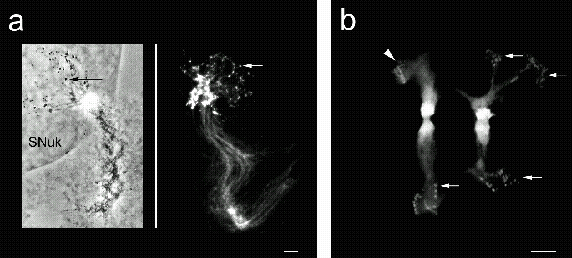Telomeric heterochromatin (tHC)
At the ends of almost all polytene chromosomes appeared dot-like compaction of chromatin, which in phase contrast appeared black or in the DAPI fluorescence very bright (see figure a). In their presence and their expressions the dot-like compaction correspond to those structures described by that Schweizer (1976b) as telomeric heterochromatin.
The individual dots of the telomeric heterochromatin (tHC) were depending on the state of condensation of the surrounding chromatin (figure b). If the chromatin was loose, then the single dots of the tHC were individually identifiable (arrows). Appeared the chromatin in the vicinity of tHC, however, condensed, then the dots of tHC formed a highly packed accumulation. These accumulations could take various forms, such as a band like in Figure b (arrowhead).

Scale bar represents 10 µm.

